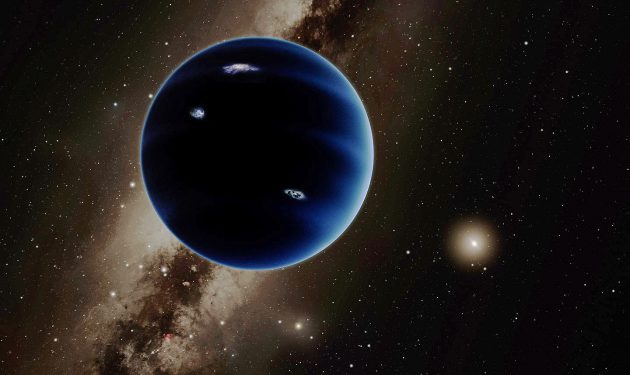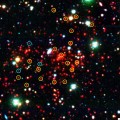By Christine Pulliam

Artist’s conception of Planet Nine. (Image courtesy Caltech/R. Hurt)
Earlier this year scientists presented evidence for Planet Nine, a Neptune-mass planet in an elliptical orbit 10 times farther from our Sun than Pluto. Since then theorists have puzzled over how this planet could end up in such a distant orbit.
New research by astronomers at the Harvard-Smithsonian Center for Astrophysics (CfA) examines a number of scenarios and finds that most of them have low probabilities. Therefore, the presence of Planet Nine remains a bit of a mystery.
“The evidence points to Planet Nine existing, but we can’t explain for certain how it was produced,” says CfA astronomer Gongjie Li, lead author on a paper accepted for publication in the Astrophysical Journal Letters.
Planet Nine circles our Sun at a distance of about 40 billion to 140 billion miles, or 400 – 1500 astronomical units. (An astronomical unit or A.U. is the average distance of the Earth from the Sun, or 93 million miles.) This places it far beyond all the other planets in our solar system. The question becomes: did it form there, or did it form elsewhere and land in its unusual orbit later?
Li and her co-author Fred Adams (University of Michigan) conducted millions of computer simulations in order to consider three possibilities. The first and most likely involves a passing star that tugs Planet Nine outward. Such an interaction would not only nudge the planet into a wider orbit but also make that orbit more elliptical. And since the Sun formed in a star cluster with several thousand neighbors, such stellar encounters were more common in the early history of our solar system.
However, an interloping star is more likely to pull Planet Nine away completely and eject it from the solar system. Li and Adams find only a 10 percent probability, at best, of Planet Nine landing in its current orbit. Moreover, the planet would have had to start at an improbably large distance to begin with.
CfA astronomer Scott Kenyon believes he may have the solution to that difficulty. In two papers submitted to the Astrophysical Journal, Kenyon and his co-author Benjamin Bromley (University of Utah) use computer simulations to construct plausible scenarios for the formation of Planet Nine in a wide orbit.
“The simplest solution is for the solar system to make an extra gas giant,” says Kenyon.
They propose that Planet Nine formed much closer to the Sun and then interacted with the other gas giants, particularly Jupiter and Saturn. A series of gravitational kicks then could have boosted the planet into a larger and more elliptical orbit over time.
“Think of it like pushing a kid on a swing. If you give them a shove at the right time, over and over, they’ll go higher and higher,” explains Kenyon. “Then the challenge becomes not shoving the planet so much that you eject it from the solar system.”
That could be avoided by interactions with the solar system’s gaseous disk, he suggests.
Kenyon and Bromley also examine the possibility that Planet Nine actually formed at a great distance to begin with. They find that the right combination of initial disk mass and disk lifetime could potentially create Planet Nine in time for it to be nudged by Li’s passing star.
“The nice thing about these scenarios is that they’re observationally testable,” Kenyon points out. “A scattered gas giant will look like a cold Neptune, while a planet that formed in place will resemble a giant Pluto with no gas.”
Li’s work also helps constrain the timing for Planet Nine’s formation or migration. The Sun was born in a cluster where encounters with other stars were more frequent. Planet Nine’s wide orbit would leave it vulnerable to ejection during such encounters. Therefore, Planet Nine is likely to be a latecomer that arrived in its current orbit after the Sun left its birth cluster.
Finally, Li and Adams looked at two wilder possibilities: that Planet Nine is an exoplanet that was captured from a passing star system, or a free-floating planet that was captured when it drifted close by our solar system. However, they conclude that the chances of either scenario are less than 2 percent.
Li and Adams’ paper has been accepted for publication in the Astrophysical Journal Letters and is available online. Kenyon and Bromley have submitted their findings to the Astrophysical Journal in two papers available online: one on in-situ formation and one on gas-giant scattering.





